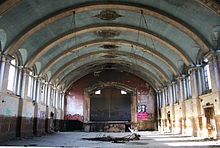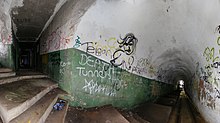Urban exploration

Urban exploration (often shortened as urbex or UE) is the examination of the normally unseen or off-limits parts of urban areas or industrial facilities.[1] Urban exploration is also commonly referred to as infiltration, although some people consider infiltration to be more closely associated with the exploration of active or inhabited sites. It may also be referred to as draining (when exploring drains) urban spelunking, urban caving, or building hacking.
The nature of this activity presents various risks, including both physical danger and the possibility of arrest and punishment. Many, but not all, of the activities associated with urban exploration could be considered trespassing or other violations of local or regional laws, including—but not limited to—invasion of privacy and certain broadly-interpreted anti-terrorism laws.[2]
Targets of exploration
[edit]
Urban explorers often attempt some or all of these subsets of urban exploration.
Abandonments
[edit]Ventures into abandoned structures are perhaps the most common example of urban exploration. At times, sites are entered first by locals, and may sport large amounts of graffiti and other acts of vandalism. Explorers face various risks in abandoned structures including collapsing roofs and floors, broken glass, guard dogs, the presence of chemicals and other harmful substances, most notably asbestos, hostile squatters and motion detectors. Some explorers wear respirators to protect their airways and proper attire to protect their bodies.
Although targets of exploration vary from one country to another, high-profile abandonments include amusement parks, grain elevators, factories, power plants, missile silos, fallout shelters, hospitals, asylums, schools, poor houses, and sanatoriums.
In Japan, ruins are known as haikyo (廃虚?), (literally "abandoned place") but the term is synonymous with the practice of urban exploration.[3] Haikyo are particularly common in Japan because of its rapid industrialization (e.g., Hashima Island), damage during World War II, the 1980s real estate bubble and the 2011 Tōhoku earthquake and tsunami.[4]
Many explorers find decay of uninhabited space to be profoundly beautiful and some are also proficient freelance photographers. Abandoned locations can be, at times, heavily guarded with motion sensors and active security. Others are more easily accessible and carry less risk of discovery. Abandoned sites are also popular among historians, preservationists, architects, archaeologists, industrial archaeologists, and ghost hunters.
Active buildings
[edit]Another aspect of urban exploration is the practice of exploring active or in use buildings which includes gaining access to secured or "member-only" areas, mechanical rooms, roofs, elevator rooms, abandoned floors and other normally unseen parts of working buildings. The term "infiltration" is often associated with the exploration of active structures. People entering restricted areas may be committing trespass and civil prosecution may result.

Catacombs
[edit]Catacombs such as those found in Paris, Rome, Odessa and Naples have been investigated by urban explorers. The Mines of Paris, comprising much of the underground tunnels that are not open to public tourism like the catacombs, have been considered the "Holy Grail" by some due to their extensive nature and history. Explorers of these are known as cataphiles.

Sewers and storm drains
[edit]Entry into storm drains, or draining, is another common form of urban exploration. Groups devoted to the task have arisen, such as the Cave Clan in Australia. Draining has a specialized set of guidelines, the foremost of which is "When it rains, no drains!" The dangers of becoming entrapped, washed away, or killed increase dramatically during a heavy rainfall.
A small subset of explorers enter sanitary sewers. Sometimes they are the only connection to caves or other subterranean features. Sewers are among the most dangerous locations to explore owing to risk of poisoning by buildups of toxic gas (commonly methane and hydrogen sulfide). There have been numerous fatalities around the world where people are overcome by toxic gas from sewers.
Transit tunnels
[edit]Exploring active and abandoned subway and underground railway tunnels, bores and stations is often considered to be trespassing and can result in civil prosecution. As a result, this type of exploration is rarely publicized. One important exception to this is the abandoned subway of Rochester, NY, the only American city to have an abandoned, formerly used, subway system. (The Cincinnati subway is also abandoned but was never completed.)
Utility tunnels
[edit]
Universities and other large institutions, such as hospitals, often distribute steam for heating buildings and autoclaves from a central heating plant. These high pressure steam pipes are generally run through utility tunnels, which are often accessible solely for the purposes of maintenance. Many of these steam tunnels, such as those on college campuses, often also have a tradition of exploration by its students. This was once called vadding at MIT, though students there now refer to it as roof and tunnel hacking.
Steam tunnels, in general, have been secured heavily in recent years, due to their use for carrying network backbones and perceived risk of their use in terrorist activities, safety and liability.
Some steam tunnels have dirt floors, no efficient lighting and have temperatures upwards of 45 °C (113 °F). Others have concrete floors, bright light, and feature a cool low-grade temperature. Most steam tunnels have large intake fans to bring in fresh air and push the hot air out the back. Most active steam tunnels do not contain airborne asbestos but proper breathing protection may be required for other hazards. It is wise to take proper care inside active utility tunnels, since pipes can spew boiling hot water from leaky valves, puddles pool at your feet, and forceful steam may leak inward resulting in burns and slips.
Popularity
[edit]The rise in the popularity of urban exploration can be attributed to its increased media attention. Recent television shows, such as Urban Explorers on the Discovery Channel, MTV's Fear, and the Ghost Hunting exploits of The Atlantic Paranormal Society have packaged the hobby for a popular audience. Talks and exhibits on urban exploration have appeared at the 5th and 6th Hackers on Planet Earth Conference, complementing numerous newspaper articles and interviews.
With the rise in the relative popularity of the hobby due to this increased focus, there has been increasing discussion on whether the extra attention has been beneficial to urban exploration as a whole. The unspoken rule of urban exploring is "take nothing but photographs, leave nothing but footprints", but because of the rising popularity, many individuals who may have other intentions are creating a concern among many property owners.
Safety and legality
[edit]Urban exploration is a hobby that comes with a number of inherent dangers. Storm water drains are not designed with human access as their primary use. They can be subject to flash flooding and bad air. There have been a number of deaths in storm water drains, but these are usually during floods, and are normally not Urban Explorers.[5][dead link]
Many old abandoned structures feature hazards such as unstable structures, unsafe floors, asbestos, carbon monoxide, carbon dioxide, exposed electrical wires and entrapment hazards.[6]
Asbestos is a long term health risk for urban explorers, along with breathing in contaminants from dried bird feces, otherwise known as pigeon lung, a form of hypersensitivity pneumonitis. Urban explorers may use dust masks and respirators to alleviate this danger. Some sites are occasionally used by substance abusers for either recreation or disposal, and there may be used and/or infected syringe needles en route, such as those commonly used with heroin.
The growing popularity of the activity has resulted not just in increased attention from explorers, but also from vandals and Law Enforcement. The illicit aspects of urban exploring, which may include trespassing and breaking and entering,[7] have brought along with them critical articles in mainstream newspapers.[8]
In Australia, the web-site of the Sydney Cave Clan was shut down by lawyers for the Roads and Traffic Authority of New South Wales, after they raised concerns that the portal could "risk human safety and threaten the security of its infrastructure."[8] Another web-site belonging to the Bangor Explorers Guild was criticized by the Maine State Police for potentially encouraging behavior that "could get someone hurt or killed."[8] Likewise, the Toronto Transit Commission has also used the Internet to crimp Subway Tunnel Explorations, going as far as to send Investigators to various Explorers' homes.[8]
Jeff Chapman, who authored Infiltration, stated that genuine urban explorers "never vandalize, steal or damage anything." The thrill comes from that of "discovery and a few nice pictures."[8] Some Explorers will also request permission for entry.[9]
See also
[edit]References
[edit]- ^ Nestor, James (19 August 2007). "The Art of Urban Exploration". San Francisco Chronicle. Retrieved 2008-06-20.
- ^ Haeber, Jonathan (21 December 2008). "Complete Guide to Urban Exploration". Bearings. Retrieved 2009-09-30.
- ^ "The Hazards of Haikyo and Urban Exploration". Retrieved June 21, 2011.
- ^ "Haikyo: Abandoned Treasure". Weekender. May 2010. Retrieved November 18, 2010.
- ^ "Boy, 14, drowns in drain during heavy rains". GNA. 4 June 2007. Retrieved 2008-08-09. [dead link]
- ^ Owen, Mary (5 December 2004). "Abandoned beauties: Urban explorers find adventure in ruins of old buildings". The San Diego Union Tribune. Retrieved 2009-07-27.
- ^ http://www.bbc.co.uk/tyne/content/articles/2008/08/19/urban_explorer_feature.shtml
- ^ Jump up to: a b c d e Batz Jr., Bob (7 September 2003). "Urban explorers dare to investigate seldom-seen Pittsburgh sites". Pittsburgh Post-Gazette. Retrieved 2008-06-20.
- ^ Ebaster, Al (19 September 2007). "Legal Urban Exploration: 7 Tips for Visiting Historical Abandonments". Web Urbanist.
Further reading
[edit]- Ninjalicious (2005). Access All Areas: A user's guide to the art of urban exploration. PO Box 13, Station E, Toronto, ON M6H 4E1 Canada: Infilpress. ISBN 0-9737787-0-9
- Margaine, Sylvain (2009) Forbidden Places: Exploring Our Abandoned Heritage (Hardcover), ISBN 2-915807-82-5
- Paiva, Troy (2008) Night Vision: The Art of Urban Exploration Chronicle Books ISBN 0-8118-6338-7
- Bradley L. Garrett's Urban Explorers: Quests for Myth, Mystery and Meaning (2009), a 30-minute documentary on urban exploration using the work of 5 British academics to discuss motivations behind the practice.
- Melody Gilbert's Urban Explorers: Into the Darkness (2007), a documentary about some of the world's urban explorers.
- ABANDONED - adventures of Urban exploration (2011), photos from abandoned places. By Jan Elhøj and Morten Kirckhoff., ISBN 978-87-92359-35-3
External links
[edit]el:Αστική Εξερεύνηση eu:Hiri esplorazioa lt:Miestų tyrinėtojas pt:Exploração urbana sk:Urban exploration fi:Urbaani löytöretkeily
- Pages using the JsonConfig extension
- All articles with dead external links
- Articles with dead external links from September 2010
- Articles with invalid date parameter in template
- Articles with hatnote templates targeting a nonexistent page
- Missing redirects
- Articles containing Japanese language text
- Articles with dead external links from March 2011
- Pages using div col with unknown parameters
- Adventure travel
- Urban exploration
- Subterranea (geography)
- Hobbies
- Backpacking
- Urban decay
- Psychogeography
